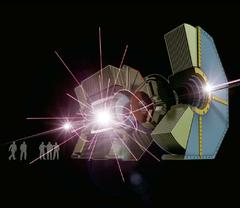A 3D rendering of the Belle II detector. Picture: KEK / Rey.Hori
The Belle II collaboration has made the most precise measurement of the mass of the tau lepton, or tauon, to date. Scientists working on the Belle II detector at the Japanese research lab KEK report the tau lepton to have a mass of 1777.09 ± 0.14 MeV, which is consistent with previous measurements. The study was led by scientists from DESY.
The Standard Model is a theory in particle physics that describes the fundamental particles and their interactions through three of the fundamental forces of nature (electromagnetic, weak, and strong forces) that we observe in the universe. It is considered the most accurate and comprehensive theory of particle physics to date. In the Standard Model, there are twelve different types of elementary particles: six quarks and six leptons. Despite its successes, the Standard Model is not complete, as it does not include a theory of gravity, and it does not explain dark matter or dark energy, which are believed to make up most of the matter and energy in the universe.
The six known types of leptons are arranged in three generations or "flavours": the electron and electron neutrino, muon and muon neutrino, tau and tau neutrino. The electron, muon and tau have electric charge, while the neutrinos, as the name suggests, are neutral. The tau lepton was discovered in a series of experiments between 1974 and 1977 at the SLAC research centre in the United States. Scientists have been studying the properties of the tau lepton for decades to gain a better understanding of its behavior. The tau lepton is similar to the other two charged leptons but it is much heavier – about 3,477 heavier than the electron and about 17 times heavier than the muon. However, unlike its lighter cousins, the electron or muon, the properties of the tau lepton, such as its mass, have not been yet measured with the same level of precision. The properties of the tau are much more difficult to study than those of the electron and the muon because taus don’t hang around for long enough. Electrons are stable particles, which means that most of the electrons that are around us have been around since the beginning of the universe. On the other hand, muon and tau particles are both unstable: they each decay into other particles after some time. While the lifetime of the muon is already quite small (around 2 millionths of a second), the tau’s lifetime is even shorter by about 10 million times! In about 2.9 x 10-13 seconds, tau leptons decay to a W boson and a tau neutrino. The W boson, in turn, can produce either a quark pair – which cannot exist in isolation, but must always be coupled to other quarks to form composite particles such as mesons – or a pair of leptons – an electron and electron neutrino, or muon and muon neutrino. There are always neutrinos involved in the tau decays which simply fly through any kind of material and are thus not detected by experimental instruments. For researchers this means that they can only gain information about the taus from a fraction of the decay products. Thus, studying the tau lepton’s properties is a challenge for particle physicists. However, it is important to know the properties of the tau, such as mass, as precisely as possible for testing the Standard Model of Particle Physics and searching for signs of new physics beyond it.
For example, there is a predicted relation between the decay rate of the tau into a lighter lepton and its decay time for a given measured tau mass. That relation is very sensitive to the value of the tau mass. Using the world average result of the tau mass, 1776.86 ± 0.12 MeV, from the Particle Data Group (PDG), the researchers see a slight disagreement between the prediction and the values they measured. If this tension increases with more precise measurements, this could signal the presence of new physics beyond the Standard Model. On the other hand, if the more precise measurements prove to be consistent with the existing value, the new measurements will improve our knowledge of the Standard Model.
Researchers from DESY led the analysis to determine the tau mass. The data they used was collected during 2019 and 2021 by the Belle II detector, located at the SuperKEKB accelerator in Japan. SuperKEKB collided 7-GeV electrons and 4-GeV positrons, during which about 175 million tau-pair events were produced. For the mass measurement, the researchers studied the decays of tau leptons to three pions and a tau neutrino, and used a technique that was originally developed by the ARGUS collaboration at DESY back in 1992. In this method the challenge lies in the precise study of the decay and the electron-positron collision energy. These components drive the precision of the measurement. By studying those decays, the researchers measured the mass of the tau to be 1777.09 ± 0.14 MeV. This result is consistent with previous measurements. But impressively, it provides the best single-measurement precision to date. “This will certainly improve our understanding of the tau lepton properties and of the Standard Model,” explains DESY scientist Armine Rostomyan, “and motivate researchers to explore new ideas to measure the tau mass with even greater precision.”








